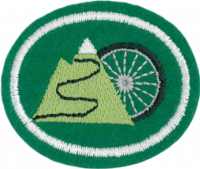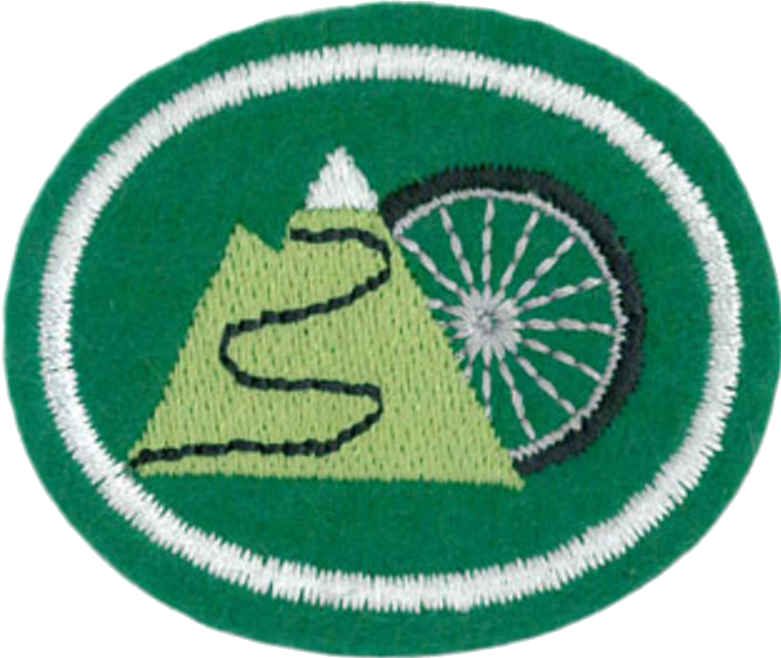Difference between revisions of "AY Honors/Mountain Biking/Answer Key/es"
From Pathfinder Wiki
< AY Honors | Mountain BikingAY Honors/Mountain Biking/Answer Key/es
(Created page with "</noinclude> <!-- 1. Tener la especialidad de Ciclismo. --> {{honor_prerequisite/es|category=Recreation|honor=Cycling|displayname=Ciclismo}}") |
|||
| (23 intermediate revisions by 2 users not shown) | |||
| Line 1: | Line 1: | ||
| − | + | {{HonorSubpage}} | |
| − | |||
| − | {{ | ||
| − | |||
| − | |||
| − | |||
| − | |||
| − | |||
| − | |||
| − | |||
| − | }} | ||
| − | |||
| − | |||
<section begin="Body" /> | <section begin="Body" /> | ||
{{ansreq|page={{#titleparts:{{PAGENAME}}|2|1}}|num=1}} | {{ansreq|page={{#titleparts:{{PAGENAME}}|2|1}}|num=1}} | ||
<noinclude></noinclude> | <noinclude></noinclude> | ||
<!-- 1. Tener la especialidad de Ciclismo. --> | <!-- 1. Tener la especialidad de Ciclismo. --> | ||
| − | {{honor_prerequisite | + | {{honor_prerequisite|honor=Cycling|displayname=Ciclismo}} |
<noinclude></noinclude> | <noinclude></noinclude> | ||
| Line 22: | Line 10: | ||
{{ansreq|page={{#titleparts:{{PAGENAME}}|2|1}}|num=2}} | {{ansreq|page={{#titleparts:{{PAGENAME}}|2|1}}|num=2}} | ||
<noinclude></noinclude> | <noinclude></noinclude> | ||
| − | <!-- 2. | + | <!-- 2. Usando una bicicleta de montaña y una bicicleta de carretera a modo de ejemplo, mostrar y describir las cinco diferencias entre bicicletas de montaña y las de carretera. --> |
| − | + | {{clear}} | |
| − | |||
| − | |||
| − | |||
| − | |||
<noinclude></noinclude> | <noinclude></noinclude> | ||
| Line 34: | Line 18: | ||
{{ansreq|page={{#titleparts:{{PAGENAME}}|2|1}}|num=3}} | {{ansreq|page={{#titleparts:{{PAGENAME}}|2|1}}|num=3}} | ||
<noinclude></noinclude> | <noinclude></noinclude> | ||
| − | <!-- 3. | + | <!-- 3. Demostrar la función y las ventajas de los calzapiés, los cuernos del manubrio y amortiguador en una bicicleta de montaña. --> |
<noinclude></noinclude> | <noinclude></noinclude> | ||
{{CloseReq}} <!-- 3 --> | {{CloseReq}} <!-- 3 --> | ||
{{ansreq|page={{#titleparts:{{PAGENAME}}|2|1}}|num=4}} | {{ansreq|page={{#titleparts:{{PAGENAME}}|2|1}}|num=4}} | ||
<noinclude></noinclude> | <noinclude></noinclude> | ||
| − | <!-- 4. | + | <!-- 4. Hacer una lista de al menos tres materiales con los cuales se fabrican marcos de bicicletas de montaña y explicar por qué nuevos materiales son siempre puestos a prueba para los marcos de bicicletas de montaña. --> |
| − | + | {{clear}} | |
| − | |||
| − | |||
| − | |||
| − | + | {{clear}} | |
<noinclude></noinclude> | <noinclude></noinclude> | ||
| Line 52: | Line 33: | ||
{{ansreq|page={{#titleparts:{{PAGENAME}}|2|1}}|num=5}} | {{ansreq|page={{#titleparts:{{PAGENAME}}|2|1}}|num=5}} | ||
<noinclude></noinclude> | <noinclude></noinclude> | ||
| − | <!-- 5. | + | <!-- 5. Explicar las diferencias entre la vía única, la doble vía y las vías de incendios. --> |
| − | |||
<noinclude></noinclude> | <noinclude></noinclude> | ||
| Line 59: | Line 39: | ||
{{ansreq|page={{#titleparts:{{PAGENAME}}|2|1}}|num=6}} | {{ansreq|page={{#titleparts:{{PAGENAME}}|2|1}}|num=6}} | ||
<noinclude></noinclude> | <noinclude></noinclude> | ||
| − | <!-- 6. | + | <!-- 6. Dar la definición de los términos «cuadros sin suspensión» y «suspensión total» y explicar las ventajas y desventajas de una bicicleta de suspensión total frente a una de cuadro sin suspensión. --> |
| − | |||
| − | + | {{clear}} | |
| − | + | {{clear}} | |
<noinclude></noinclude> | <noinclude></noinclude> | ||
| Line 70: | Line 49: | ||
{{ansreq|page={{#titleparts:{{PAGENAME}}|2|1}}|num=7}} | {{ansreq|page={{#titleparts:{{PAGENAME}}|2|1}}|num=7}} | ||
<noinclude></noinclude> | <noinclude></noinclude> | ||
| − | <!-- 7. | + | <!-- 7. Describir las normas básicas de cortesía que deberían seguirse cuando se hace ciclismo fuera de la carretera. --> |
| − | + | {{clear}} | |
| − | + | {{clear}} | |
| − | + | {{clear}} | |
<noinclude></noinclude> | <noinclude></noinclude> | ||
| Line 82: | Line 61: | ||
{{ansreq|page={{#titleparts:{{PAGENAME}}|2|1}}|num=8}} | {{ansreq|page={{#titleparts:{{PAGENAME}}|2|1}}|num=8}} | ||
<noinclude></noinclude> | <noinclude></noinclude> | ||
| − | <!-- 8. | + | <!-- 8. Hacer una lista de tres piezas básicas del equipo de seguridad que deben usarse para la bicicleta de montaña. --> |
| − | |||
| − | |||
| − | |||
| − | |||
<noinclude></noinclude> | <noinclude></noinclude> | ||
| Line 92: | Line 67: | ||
{{ansreq|page={{#titleparts:{{PAGENAME}}|2|1}}|num=9}} | {{ansreq|page={{#titleparts:{{PAGENAME}}|2|1}}|num=9}} | ||
<noinclude></noinclude> | <noinclude></noinclude> | ||
| − | <!-- 9. | + | <!-- 9. Conocer los tres huesos que se rompen con más frecuencia en accidentes de bicicleta de montaña y cómo se puede evitar que se produzcan estas lesiones. --> |
| − | |||
| − | |||
| − | |||
| − | |||
| − | |||
| − | |||
| − | |||
<noinclude></noinclude> | <noinclude></noinclude> | ||
| Line 105: | Line 73: | ||
{{ansreq|page={{#titleparts:{{PAGENAME}}|2|1}}|num=10}} | {{ansreq|page={{#titleparts:{{PAGENAME}}|2|1}}|num=10}} | ||
<noinclude></noinclude> | <noinclude></noinclude> | ||
| − | <!-- 10. | + | <!-- 10. Demostrar la manera correcta de limpiar, pulir y lubricar una bicicleta después de conducirla. --> |
<noinclude></noinclude> | <noinclude></noinclude> | ||
{{CloseReq}} <!-- 10 --> | {{CloseReq}} <!-- 10 --> | ||
{{ansreq|page={{#titleparts:{{PAGENAME}}|2|1}}|num=11}} | {{ansreq|page={{#titleparts:{{PAGENAME}}|2|1}}|num=11}} | ||
<noinclude></noinclude> | <noinclude></noinclude> | ||
| − | <!-- 11. | + | <!-- 11. Completar los siguientes requisitos de paseos en bicicleta: todos los viajes deberán ser realizados en un camino de tierra tal como camino simple y este sendero se puede utilizar durante más de un paseo o repetirlo para hacer el paseo lo suficientemente largo para cumplir los requisitos (si es necesario). --> |
| − | *'''a. | + | *'''a. Tres paseos de 5 millas (8 km)''' |
| − | *'''b. | + | *'''b. Dos paseos de 10 millas (16 km)''' |
| − | *'''c. | + | *'''c. Un paseo de 20 millas (32 km)''' |
| − | Use | + | Use un GPS o recorra el tiempo en una ruta conocida para saber cuánto tiempo tomó un viaje. Mantenga un registro de dónde, cuándo y qué distancia recorrió para demostrar que cumplió con este requisito. ¡Feliz paseo! |
<noinclude></noinclude> | <noinclude></noinclude> | ||
{{CloseReq}} <!-- 11 --> | {{CloseReq}} <!-- 11 --> | ||
<noinclude></noinclude> | <noinclude></noinclude> | ||
| − | == | + | ==Referencias== |
<noinclude></noinclude> | <noinclude></noinclude> | ||
| − | + | {{CloseHonorPage}} | |
| − | |||
Latest revision as of 00:54, 15 July 2022
Ciclismo en montaña
Nivel de destreza
2
Año
1998
Version
31.12.2025
Autoridad de aprobación
División Norteamericana
1
Tener la especialidad de Ciclismo.
Para consejos e instrucciones, véase Ciclismo.
2
Usando una bicicleta de montaña y una bicicleta de carretera a modo de ejemplo, mostrar y describir las cinco diferencias entre bicicletas de montaña y las de carretera.
3
Demostrar la función y las ventajas de los calzapiés, los cuernos del manubrio y amortiguador en una bicicleta de montaña.
4
Hacer una lista de al menos tres materiales con los cuales se fabrican marcos de bicicletas de montaña y explicar por qué nuevos materiales son siempre puestos a prueba para los marcos de bicicletas de montaña.
5
Explicar las diferencias entre la vía única, la doble vía y las vías de incendios.
6
Dar la definición de los términos «cuadros sin suspensión» y «suspensión total» y explicar las ventajas y desventajas de una bicicleta de suspensión total frente a una de cuadro sin suspensión.
7
Describir las normas básicas de cortesía que deberían seguirse cuando se hace ciclismo fuera de la carretera.
8
Hacer una lista de tres piezas básicas del equipo de seguridad que deben usarse para la bicicleta de montaña.
9
Conocer los tres huesos que se rompen con más frecuencia en accidentes de bicicleta de montaña y cómo se puede evitar que se produzcan estas lesiones.
10
Demostrar la manera correcta de limpiar, pulir y lubricar una bicicleta después de conducirla.
11
Completar los siguientes requisitos de paseos en bicicleta: todos los viajes deberán ser realizados en un camino de tierra tal como camino simple y este sendero se puede utilizar durante más de un paseo o repetirlo para hacer el paseo lo suficientemente largo para cumplir los requisitos (si es necesario).
- a. Tres paseos de 5 millas (8 km)
- b. Dos paseos de 10 millas (16 km)
- c. Un paseo de 20 millas (32 km)
- a. Tres paseos de 5 millas (8 km)
- b. Dos paseos de 10 millas (16 km)
- c. Un paseo de 20 millas (32 km)
Use un GPS o recorra el tiempo en una ruta conocida para saber cuánto tiempo tomó un viaje. Mantenga un registro de dónde, cuándo y qué distancia recorrió para demostrar que cumplió con este requisito. ¡Feliz paseo!


